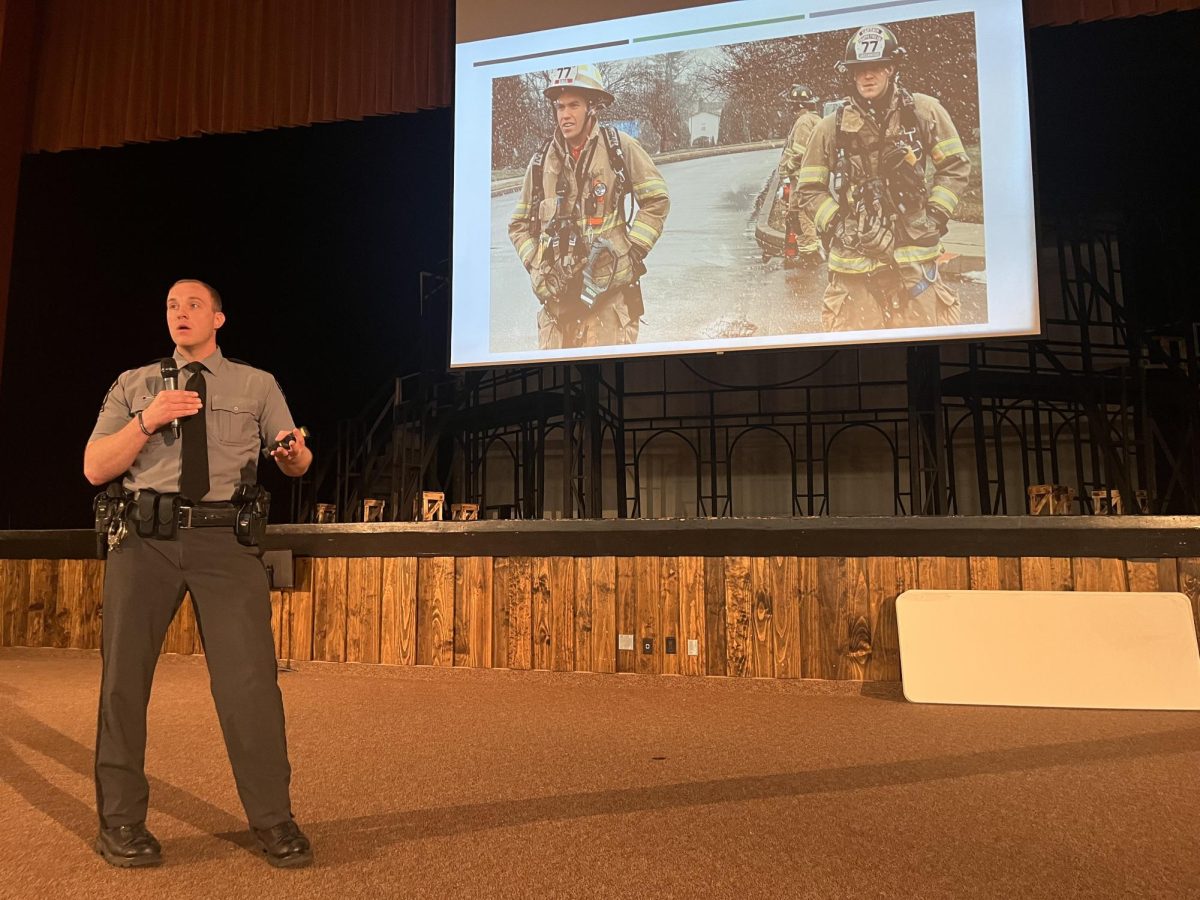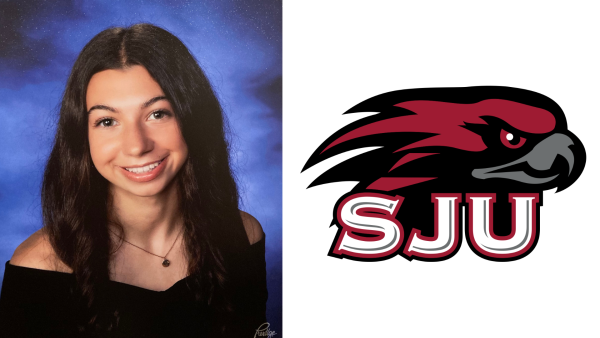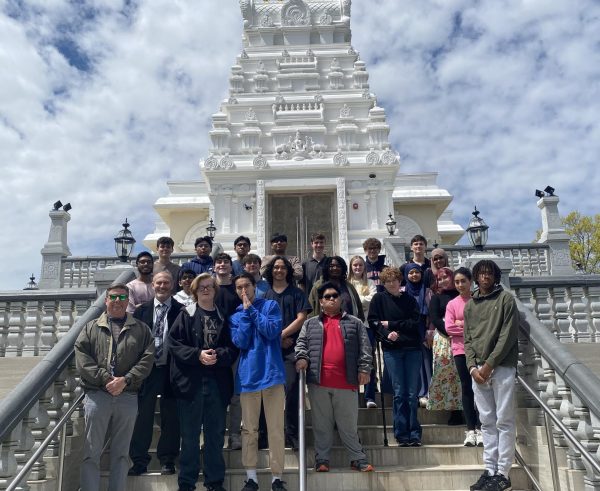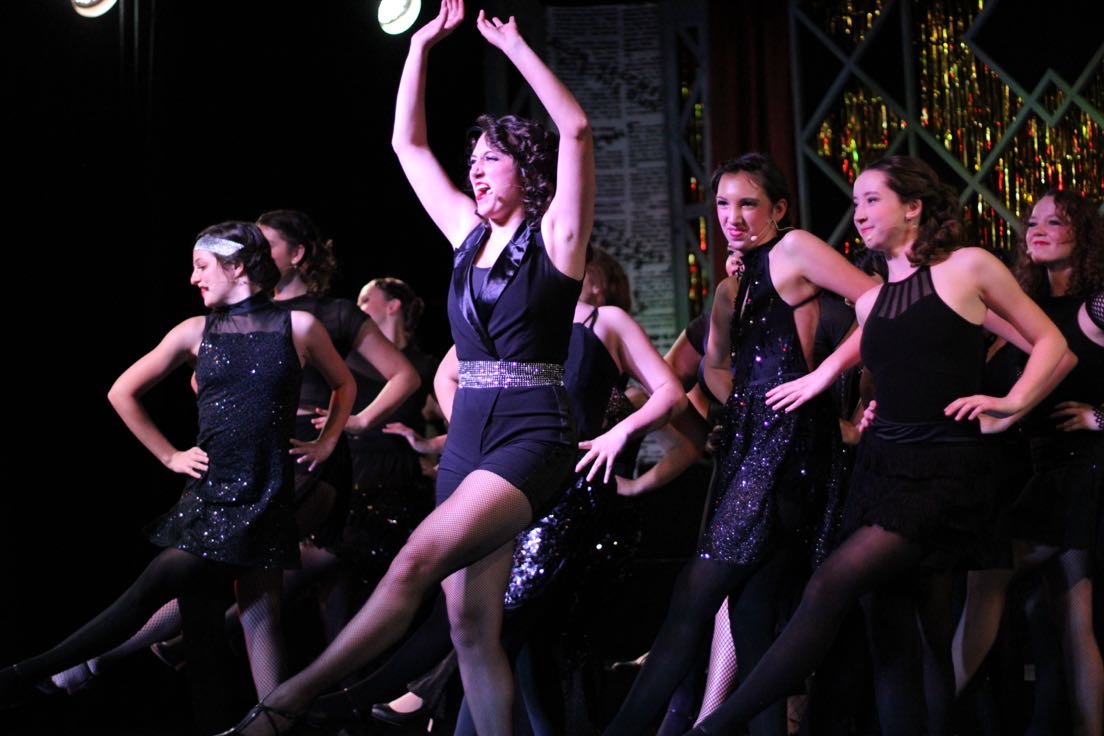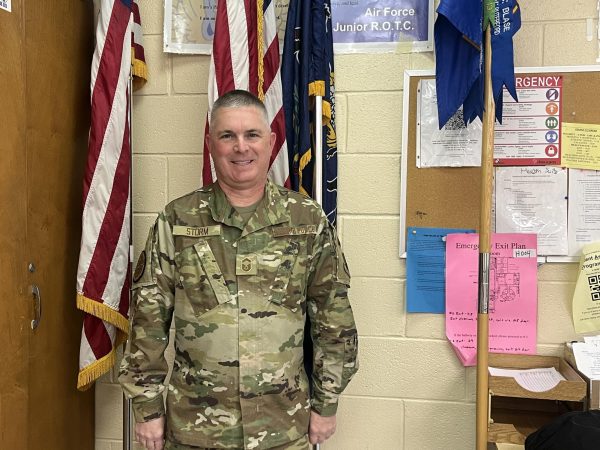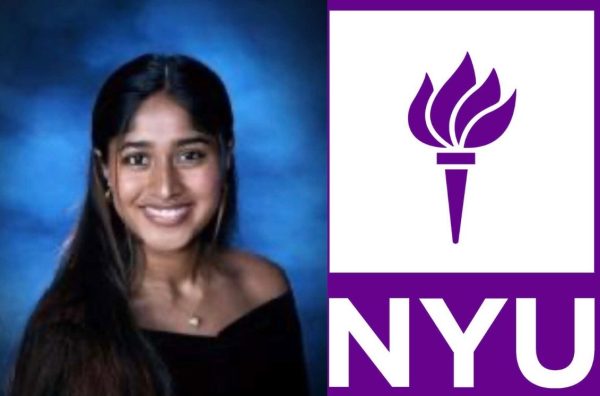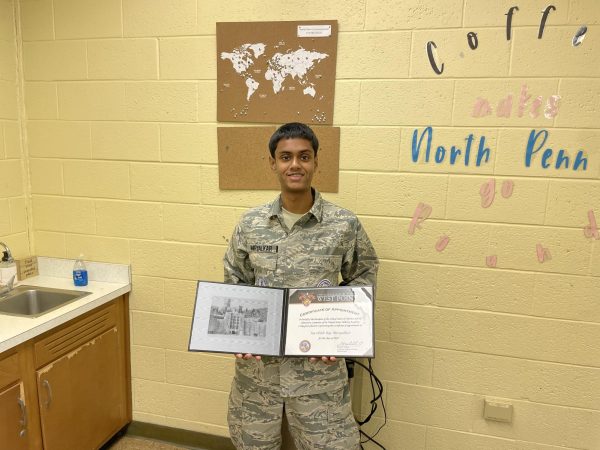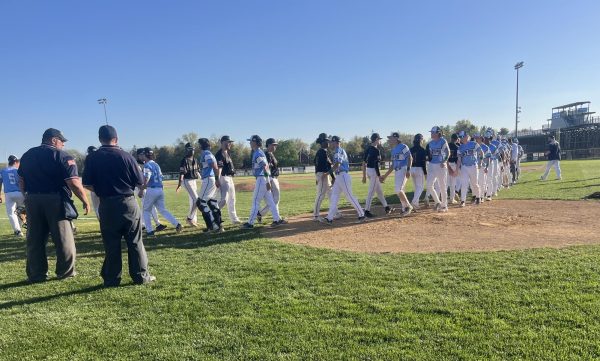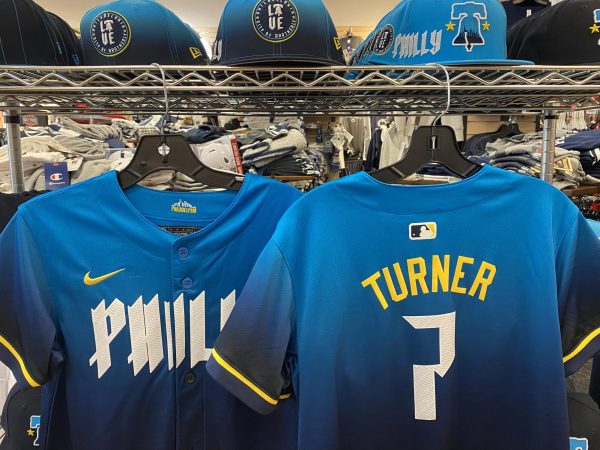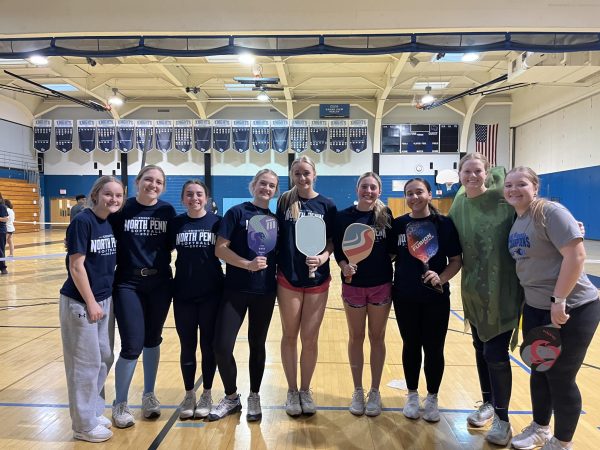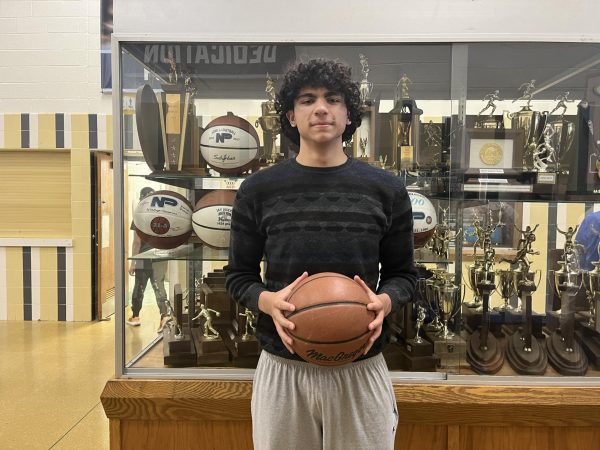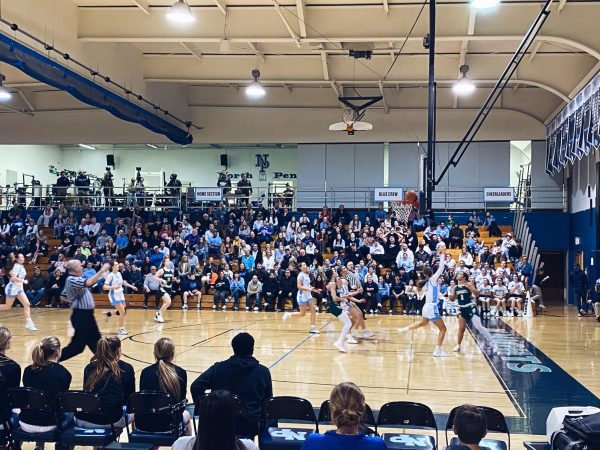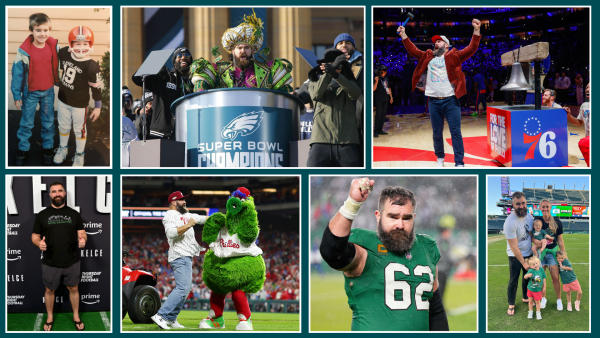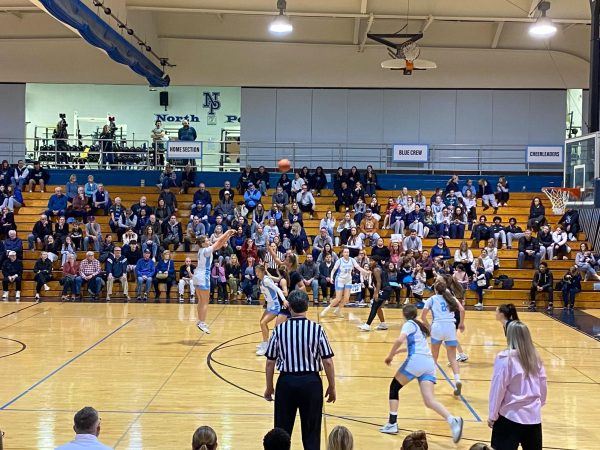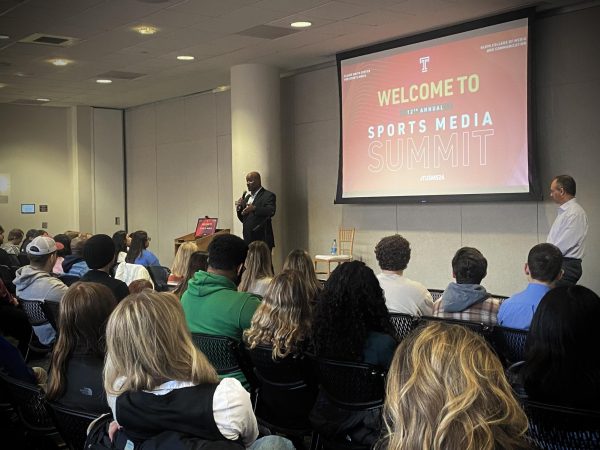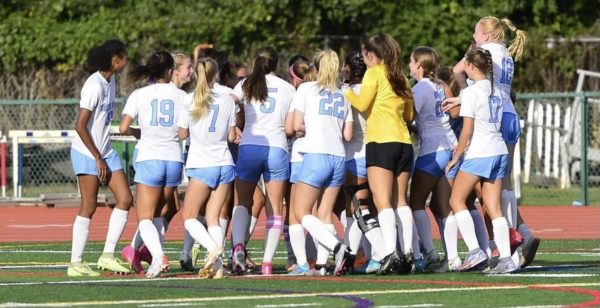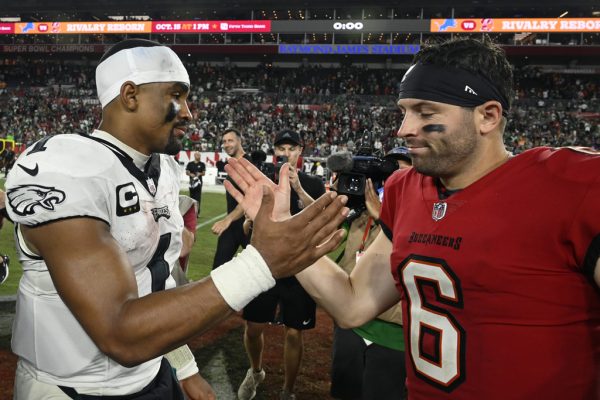Crier writers assemble mock NBA draft
May 29, 2015
NBA draft – where dreams come true. Sixty young men find out if they have what it takes to make to the Association and fulfill their childhood dream. Who will witness their dream become reality? Our own basketball experts look into their crystal ball. This is it! The best of the best, the crème de la crème! These players have established themselves as a cut above the rest. While these Top-5 picks also carries risks (Kwame Brown, anyone?), they are the best players available by far.
1. Minnesota Timberwolves – Karl-Anthony Towns C (Kentucky, Fr.)
A no-brainer pick. He is just another pillar along with Andrew Wiggins, Zach LaVine, Ricky Rubio, and to some extent, Anthony Bennett. Rim protector and a force down low, he is a perfect fit for the fortunate Timberwolves who kept their coveted first overall pick. While Towns only hit two of the eight three-pointers he took this year, his offensive potential stems from the belief that his solid free-throw percentage (81.3%) and good mechanics can translate into legitimate floor stretching ability out to the three-point line. As the year progressed, Towns looked more and more comfortable in the post, being more aggressive and using an impressive hook-shot to score on opponents. Defense, however, is what will distinguish Towns from Okafor. He holds value as a rim protector, blocking 4.3 shots per 40 minutes at Kentucky, even though he often gets caught on pump-fakes and fouls too much (5.6 per 40 minutes). But he has good lateral quickness, which helps when defending pick and rolls, and the ability to step out and serviceably guard on the perimeter has become almost essential to star NBA big men. Ultimately, you take Towns first because of his potential as a defensive anchor and offensive floor-spacer.
2. Los Angeles Lakers – Jahlil Okafor C (Duke, Fr.)
Jumping ahead of the Sixers and the Knicks, the Lakers can grab a center that will prolong the legacy of great centers that has defended Gold and Purple. Jahlil Okafor can score at will, even at the NBA level, with his post moves, as well as facing up. While he is not the best defender, Los Angeles would be silly not to take him to add to their great pantheon of low-post big men. With hands that are the size of baseball gloves, Okafor controls the ball in a way that has not ever been seen before by someone of his size and age. He has countermoves to his countermoves, able to break down a defender using angles and his strength, as well as excellent footwork. Defensively, Duke often had to hide him on pick and rolls, as his lack of lateral agility made him a liability picking up ball-handlers on a switch or recovering on the rollman. However, he controls the boards and, more importantly, is the prospect that is the most ready to play next season, something that the Lakers should value above all else.
3. Philadelphia Sixers – D’Angelo Russell PG/SG (Ohio State, Fr.)
The next James Harden? Russell perfectly fits in the Sixers as a combo guard with unlimited offensive potential. The need at backcourt is desperate as they have already established a solid frontcourt with Noel, Embiid, and Covington. While Mudiay have higher ceiling, Russell is a better shooter and much safer option. He has good size for the position at 6’5”, and while a bit skinny, he makes up for it with a tremendously high level of skill. His ability to create off the bounce and to knock down three-pointers at a high rate (41% from three) would add a dimension that the Sixers are sorely missing on their roster. What impresses the most about Russell is his ability to see plays before they happen and set up his teammates accordingly, as well as the confidence and leadership he carries at such a young age. He is probably the man that Sam Hinkie has been after all along this year, and may be the best player of this draft when it is all said and done.
4. New York Knicks – Emmanuel Mudiay PG/SG (International, 19)
Dropping down two spots, the Knicks can fill a glaring hole in PG with the mystery man, Mudiay. Ultra-athletic and exciting, the combo guard has an unlimited upside, along with a huge risk as well. However, his potential is too much to drop farther than Top-4. While they may trade down and go after Cauley-Stein or Winslow, Mudiay’s potential starpower should be enough to convince Derek Fisher to change his offense to play more to Mudiay’s strengths. His ability to operate in pick-and-roll, a key part in today’s NBA offensive scheme, along with his pass-first approach and the size is more than good enough to run an NBA offense. While the competition he played in is questionable, as the many players in the draft has already proved that they can play in high-level Division 1 basketball, Mudiay has simply too much potential to be dropped. Passing up somebody like Mudiay just because he does not fit the triangle is foolish.
5. Orlando Magic – Stanley Johnson SF/SG (Arizona, Fr.)
While many stab Winslow in as a lock to Magic, we disagree. Stanley Johnson and Justise Winslow are very similar players – both athletic and a great defender – but given the fact that the Magic backcourt cannot shoot to save their lives, Johnson makes more sense. While Winslow gained attention playing as a power forward for Duke during the tournament, Johnson was a legit small forward all year, and excelled at the position. He has a diesel frame (6’7”, 242 lbs) that he uses to body defenders on and off the ball, and unlike Winslow, displayed consistent mechanics when shooting, setting his feet and getting good arc on the ball. His midrange game is also miles ahead of Winslow’s, and while he struggles to finish at the rim, he handles the ball well in pick and rolls, and is comfortable creating for himself off the bounce, possessing a good floater and pull-up jumper. Johnson’s shooting and defensive ability make more sense for this Magic team that wants to win now.
- Sacramento Kings – Kristaps Porzingis PF/C (International, 19)
This is a no-brainer for us. The Kings do not need a wing or a center, as they either have an elite player (DeMarcus Cousins) or plenty of potential (Nik Stauskas and Ben McLemore). It is too early to reach for a PG, so why not pick up a big European who can stretch the floor? Many picked Willie Cauley-Stein at 6, but given the fact that Cauley-Stein struggled with two-center system and neither “Trill” nor “Boogie” can shoot from three, it seems illogical. George Karl’s system values spacing and a breakneck pace, and since they have already publicly stated their desire to make Cousins the offensive focal point on the low block, having someone who can shoot and run the floor is an absolute necessity for the Kings. Porzingis is a fluid shooter with range that extends to the three-point line (36.6% in Spanish ACB and Eurocup games), and his length and athleticism allow him to play above the rim. The Kings have been looking for a power forward that could either shoot or block shots and play above the rim. In Porzingis, Sacramento could get both.
- Denver Nuggets – Justise Winslow SF/SG (Duke, Fr.)
The Nuggets are a mess, and they just need to go with the best player on board. Winslow drops into their lap as Denver needs any talent they can muster at this point. The Duke product fits in well with the high pace, high energy system in Mile High City. While he is raw offensively, Winslow projects as a plus defender right away. With a giant wingspan and lightning quick agility, Winslow can be a ball hawk right away. Duke played him at the power forward position in the NCAA Tournament, and while he probably won’t be able to do so in the NBA, it showcased his talent for rebounding and finishing at the rim. Winslow loves to get out on the break, and he uses great athleticism to finish at and above the rim. He shot well from three-point range (41.8%), which bodes well for him despite the fact that it may not be sustainable. Winslow’s biggest weakness is his mid-range shooting ability: he has none. His ball-handling also leaves something to be desired, but the Nuggets are not in a position to be picky. They need talent, plain and simple.
- Detroit Pistons – Mario Hezonja SG/SF (International, 20)
Stan Van Gundy loves his shooters, as we witnessed it at Orlando, and the Pistons need more wing depth. Mario Hezonja fits the bill perfectly. With two more than competent point guards and a big man, shooter is exactly what they need. He’s more than a shooter though, as he can score at will with incredible amount of weapon he has. While he hasn’t gotten a chance to play much with Barcelona, Hezonja is not short on any confidence. With good ball handling ability and shooting ability, Hezonja also possesses breathtaking athleticism that will help him succeed in the NBA. In Barcelona he was often a little trigger happy, but that was more from an eagerness to take over games than poor decision making. He has Kobe Bryant level confidence, believing he is the best player everytime he steps on the court. That, coupled with his shooting and scoring ability, makes him a good pick for the Pistons.
- Charlotte Hornets – Willie Cauley-Stein C (Kentucky, Jr.)
Willie Cauley-Stein drops to nine, and the Hornets cannot be happier. Al Jefferson is by no means a rim protector, and his age and contract are expiring. Having an athletic monster shoulders great deal of defensive responsibility from Jefferson, and provides another big with a bright future along with Noah Vonleh and Cody Zeller. It also helps their depth, as Bismack Biyombo is a restricted free agent this offseason, and will command a long-term raise. Cauley-Stein would provide similar services (athletic play, rim protection) at a discounted price, and though his offensive game is raw right now, he’d have the opportunity to learn from the best offensive presence on the block in the league in Jefferson. And while offensively raw, Cauley-Stein athletic quickness and burst would be help to a Hornets team that values defense under Head Coach Steve Clifford.
- Miami Heat – Kelly Oubre SF (Kansas, Fr.)
If the Heat doesn’t trade their pick, which we firmly believe they should, they can go to different directions. They can draft a PG and not pay Dragic, or grab an understudy for either Wade or Deng. With some faith in Mario Chalmers, they should grab a once-hyped Kelly Oubre to look to replace restricted free agent Luol Deng. Oubre is a superb athlete that allows him to be a great defender. However, he is still raw and needs to bulk up a bit. A natural lefty with a 7’2” wingspan, Oubre often looked disinterested in his one year at Kansas and struggled to find minutes. But on a team of veterans that will hold him accountable, he can earn his minutes off the bench and learn from one of the best shooting guards of all-time in Wade. He also holds potential as an on-ball defender in case of Deng’s departure.
- Indiana Pacers – Myles Turner PF/C (Texas, Fr.)
Cameron Payne was heavily linked to the Pacers, but George Hill is underrated to say the least. Instead, Pacers should grab a big man to replace either aging David West or unreliable Roy Hibbert. Even though he is not an elite athlete, he is more than a reliable defender, and his expanding range and post moves makes him a very intriguing prospect. However, his lack of athleticism and lack of fluidity drops him out of top-10. Change is in the air for the Pacers, as both Head Coach Frank Vogel and General Manager Larry Bird have publically stated their intentions to have the Pacers playing at a faster pace next season, and picking Turner would give them an intriguing, young big man who could space the floor for Hill and bring a fresh dose of athleticism to a frontcourt that has been devoid of young legs for years.
- Utah Jazz – Frank Kaminsky PF/C (Wisconsin, Sr.)
Rudy Gobert and Derrick Favors somehow coexist with each other, despite the fact that both of them clogged up the paint. While he can’t provide defense like Gobert or Favors, Kaminsky can stretch the floor and give more breathing room for Hayward, Exum, and Burke. The Jazz were actually a competitive team after shipping Enes Kanter and his giant ego to OKC, and they have one of the, if not the best, defensive frontcourt with Gobert and Favors, but Kaminsky would be able to play next to either one while adding a new dimension to the Jazz offense that they do not have right now.
- Phoenix Suns – Cameron Payne PG (Murray State, So.)
Should they overpay Brandon Knight? No, god no. The Suns should go back to using shooting guards, with Eric Bledsoe being the man. Cameron Payne has a great shot and knows how to create things. He has a nose for a ball, but his athleticism and build holds him back a little. While he can play too fast and be trigger-happy, he is a proven leader and a good fit in the Suns. While not explosively athletic, Payne is quick and agile, and his good range coupled with his knack for breaking down defenses off the dribble make him a good fit in the Suns’ two point guard system.
- Oklahoma City Thunder – Devin Booker SG (Kentucky, Fr.)
It’s like he is made for Thunder. Who says he can’t defend? Surprising athleticism shown by Devin Booker at the combine turned a lot of heads in the NBA community, and he seems to be an instant upgrade over Anthony Morrow. With the fastest lane agility test time at the combine, Booker looked like he had plenty of defensive potential, or at least more ability than most analysts give him credit for. The Thunder has needed a tertiary scorer who can cause damage from the perimeter with deadly shooting and good off-ball movement, and value perimeter defense at the two guard. Booker has the potential to give them both.
- Atlanta Hawks – Sam Dekker SF (Wisconsin, Jr.)
With both DeMarre Carroll and Paul Millsap becoming restricted free agents at the end of the season, the Hawks may not be able to retain both of them. By drafting Sam Dekker, it allows Atlanta to go all-in for Millsap. Dekker can hit the long ball, as shown in the combine and throughout the season, and like Carroll, is a very good defender and an athlete. While he struggled behind the arc in his last two years at Wisconsin, he projects as a do-it-all glue guy, but his great athleticism and ability to play inside and out are a plus. The Hawks are now being exposed with lack of depth on the wing, and Dekker could help them in that respect.
- Boston Celtics – R. J. Hunter SG (Georgia State, Jr.)
The Celtics need a lot. Like, a lot. They need a rim protector, a shooter, and a size in backcourt. R. J. Hunter provides both incredible outside shooting and 6’ 5” presence next to diminutive Marcus Smart and Avery Bradley. While Bradley has improved as a shooter, Hunter would ultimately be a better threat due to his quick release and ball-handling ability. Also, there is no rim protector worthy of reaching at 16.
- Milwaukee Bucks – Trey Lyles PF (Kentucky, Fr.)
John Henson allows the Bucks to go for Trey Lyles, an average athlete with numerous offensive tools. He can finish through contact, score off post moves, and even hit an occasional three. His midrange game is also one of the best in the class, and he even spent time at the small forward position this year at Kentucky. He is an effort guy as he does little things and hustles. Even though he can be a liability on the defensive end, he can hold his own and have a career as a stretch 4, and Milwaukee could use someone who can spread the floor and get buckets.
- Houston Rockets – Jerian Grant PG (Notre Dame, Sr.)
We were torn between Jerian Grant and Tyus Jones, but ultimately chose the Notre Dame floor general on the basis that he is a better defender. While Jones may be a better fit offensive wise, Grant can provide much better defense and is more than capable of leading the second unit if necessary. If another defensive liability stands next to James Harden, even Dwight Howard can do so much. What Houston needs is a point guard who can play off the ball and set up his teammates, two things that incumbent starter Patrick Beverly struggles with. Grant played with another point guard at Notre Dame this season, is adept at dishing the ball, and can be a third option when Harden or Dwight gets tired.
- Washington Wizards – Bobby Portis PF/C (Arkansas, So.)
Simply put, Nene is not good enough. He doesn’t have enough range to justify himself as a stretch-4 and declining athleticism is evident. Bobby Portis has shown off some major range throughout the year and even at the combine. He has great size and rebounding at the position and is an underrated rim defender, which would hold value in Washington. The postseason showed that the Wizards are willing to transition to a offense that includes a floor spacer at the power forward. Adding him to the team full of snipers like Bradley Beal and Paul Pierce only gives John Wall more weapons.
- Toronto Raptors – Kevon Looney PF (UCLA, Fr.)
Tyler Lyles would have been perfect here, but we have to work with what we have. The Raptors’ power forwards did not match the talent it was surrounded by. Neither Patrick Peterson nor Tyler Hansbrough can protect the rim to help out Jonas Valanciunas. While Kevon Looney is a major project, he still has enough athleticism to block shots and stretch the floor for the big Lithuanian. He also crashes the boards like his life depended on it, and his ball handling ability out on the perimeter is intriguing. He’s a few years away, but is the best available player. Of course, this is if they keep the pick, which they shouldn’t.
- Dallas Mavericks – Tyus Jones PG (Duke, Fr.)
After the failed Rajon Rondo experiment, the Mavericks need a point guard in a worst way. With Monta Ellis being a ball-dominant 2-guard, someone who can play off the ball and shoot will fit in nicely. Enter Tyus Jones. While he lacks the size and athleticism to be an effective defender, his shooting stroke and play making ability makes him a valuable asset to many teams. He loves to push the ball and find teammates on the break, and his love for pull-up and spot-up jumpers would fit in nicely with Dallas.
- Chicago Bulls – Delon Wright PG/SG (Utah, Sr.)
Raise your hand if you’re confident that Derrick Rose can stay healthy. That’s what I thought. Delon Wright is a big guard who is a lock-down defender. He fits the scheme that is already in place (even though who knows what will happen when Tom Thibodeau leaves) and he gives the Bulls a reliable backup that can also play together with Rose to shoulder a defensive responsibility. While the Bulls have had success with smaller point guards on one-year deals the past few years, getting a 6’6” point guard who is a stout defender and excellent floor general on a rookie contract would be better for them.
- Portland Trail Blazers – Robert Upshaw C (Washington – dismissed, So.)
The Trail Blazers lack depth in, well, pretty much all positions. However, with Robin Lopez and LaMarcus Aldridge possibly leaving the team via free agency, the frontcourt needs desperate help. While the Blazers have Meyers Leonard, a very very fine prospect in our eyes, behind LA, there is close to no depth behind Lopez. Robert Upshaw may had some off-court issues, but his talent is undeniable. Simply stated, he’s huge, in every definition of the word, using every inch of his body to lock down the paint and rebound. His rim-protecting prowess is top-10 worthy, and he could be the biggest steal in the draft.
- Cleveland Cavaliers – Rondae Hollis-Jefferson SF (Arizona, So.)
Justin Anderson was a tempting pick, but we decided on a defensive stopper, and the best in the draft is Rondae Hollis-Jefferson. While the Cavs appear to be on a mission to collect as many shooters as possible, Hollis-Jefferson and his broken jumper are almost necessary to this team. Behind LeBron James, they lack athleticism in backup small forwards that includes Mike Miller and James Jones. Adding some toughness, and youth, to that group would be able to give an aging LeBron more breaks defensively.
- Memphis Grizzlies – Montrezl Harrell PF (Louisville, Jr.)
Never really like the tweeners. We see the likes of Derrick Williams crash from a second overall pick to a player without a position. Montrezl Harrell is not big by any means, but his energy, athleticism, wingspan, and defense is just what the Grizzlies need. He doesn’t need to be the go-to scorer, and could be lighting in a bottle when Zach Randolph needs a breather. His effort and hustle would also fit in perfectly with the Grit and Grind philosophy in Memphis.
- San Antonio Spurs – George Lucas PG (International, 19)
A bit of a mystery player from Brazil, he is a classic Spurs pick. Big for his position, while he doesn’t have a consistent jump shot, Lucas is a superb athlete who can stuff the stat sheet. Still only 19 years old, he has an unlimited potential that can evolve him into a star. He is 6’6” with a 7’0” (!) wingspan. At 18 years old, this guy could be the heir to Tony Parker’s point guard throne. Just imagine him and Kawhi Leonard lining up together on defense.
- Los Angeles Lakers – Christian Wood PF (UNLV, So.)
After drafting Jahlil Okafor, the Lakers can use a rim protector to complement the Duke big man. While Christian Wood is widely known as a floor spacer, his 6’ 11”, 220 lb frame can put some work in the paint. Long and athletic, Wood plays above the rim and on the perimeter, a natural complement to Okafor’s post-happy ways. If he puts on some extra bulk, he can be a great complimentary piece.
- Boston Celtics – Jordan Mickey PF (LSU, So.)
After addressing their shooter need in R. J. Hunter, the Celtics can find their rim protector in the LSU forward. Jordan Mickey turned many heads during combine thanks to his freaky athleticism. His five-on-five performance where he blocked shot after shot showed the glimpse of what he could do. With a team that lacks athleticism in the front court, Mickey will undoubtedly stand out amongst the celtics earth-bound big men.
- Brooklyn Nets – Justin Anderson SF/SG (Virginia, Jr.)
The Nets need to take a best talent available, and that is Justin Anderson. A great athlete with potential range, he can take over the small forward role right away or be the understudy of Joe Johnson and polish his offensive game. But most importantly, he is a young talent that Brooklyn desperately needs to gather.
- Golden State Warriors – Rakeem Christmas PF/C (Syracuse, Sr.)
Evan insisted that Rakeem Christmas is going to be a first-rounder, so here he is. That being said, the Warriors need someone who can come off the bench right away, not a raw prospect. Christmas is a polished post player who can rebound and play defense, and actually has more size than most give him credit for, checking in at the combine at 6’10” with a 7’2” wingspan. With David Lee and Marreese Speights aging, it’s not too bad for the Dub City to pick out their successor, and Christmas can play right away.
- Minnesota Timberwolves – Rashad Vaughn, SG (UNLV, Fr.)
With aging Kevin Martin and Gary Neal holding down the 2-guard spot, lights-out shooter Rashad Vaughn is a nice fit, especially given that neither Rubio nor LaVine is a shooter. His ability to space the floor will give more room for the likes of Wiggins and their first-overall pick to operate while acting as Martin’s understudy to expand his offensive tools
- Houston Rockets – Aleksander Vezenkov, SF/PF (International, 19)
They lack depth behind Trevor Ariza and Corey Brewer is not a shooter. Taking a wing sniper who can also play 4 gives the Rockets a legitimate stretch-4 not named Josh Smith.
- Boston Celtics – Dakari Johnson C (Kentucky, So.)
The first-round talent dropping to second, Dakari Johnson gives the Celtics a much-needed rim protector, because let’s face it. He is an immediate defensive upgrade over any big man they have.
- Los Angeles Lakers – Cliff Alexander PF/C (Kansas, Fr.)
Another big body the Lakers can use. Both Ed Davis and Jordan Hill could depart, leaving their front court thinner than Kevin Durant. Cliff Alexander offers another big body in the mix.
- Philadelphia Sixers – Chris McCullough, PF (Syracuse, Fr.)
The classic Sixers-injured-big-man pick. McCullough tore his ACL this past season at Syracuse, and probably will not be available until December or January. But when he was playing earlier this year for the Orange, he showed good athleticism and a midrange jump shot.
- Minnesota Timberwolves – Terry Rozier PG (Louisville, So.)
This is a case of best player available. Rubio is limited offensively but a good passer, and Zach Levine is raw but big and athletic. Rozier would be a new look off the bench, as a limited playmaker but good scorer off the bounce.
- Philadelphia Sixers – Timothe Luwawu SG (International, 20)
The Sixers are searching for an answer at both guard spots, and Luwawu may be the answer at shooting guard next to Russell. Luwawu has great size for the position, standing 6’7” with long arms and great lateral quickness, which help him profile as a solid defender in the future. He has a quick first step and can get to the rim, and also has great compact, shooting mechanics that help suggest he’ll be a solid three point threat someday. At 37, he’s loaded with potential.
- Detroit Pistons – Mouhammadou Jaiteh C (International, 20)
Andre Drummond is fantastic, but the only center behind him is Joel Anthony. When Monroe leaves this offseason, the Pistons will lose their second option at center. Jaiteh is big and physical, an excellent profile for a backup center.
- Charlotte Hornets – Michael Frazier II SG (Florida, Jr.)
The Hornets were absolutely terrible from the land of three this year. Like Mark Jackson color commentary bad. Michael Frazier has proven he can be a knockdown shooter, which Charlotte needs.
- Miami Heat – Guillermo Hernangomez C (International, 20)
Hassan Whiteside was a godsend this season for the Heat, but they had serious frontcourt depth issues. Hernangomez could be a big body that offers more potential than Chris Anderson.
- Brooklyn Nets – J. P. Tokoto SF/SG (North Carolina, Jr.)
It’s all about youth, athleticism, and VALUE for the Nets. With the unguaranteed rookie contracts now applying from picks 41-60, Brooklyn can take Tokoto, a phenomenal athlete and defender who showed some improved shooting at the combine.
- Utah Jazz – Jarell Martin PF (LSU, So.)
Jarell Martin is a similar player to Orlando Magic Forward Tobias Harris, profiling as an athletic big man who rebounds nicely despite his 6’8” frame. He will go in the second round however due to his lack of three point shooting.
- Indiana Pacers – Michael Qualls SG (Arkansas, Jr.)
Indiana wants to play faster this offseason, and could use a dose of athleticism at the shooting guard. Qualls is one of the best athletes in the draft, and showed improved scoring ability this past season at Arkansas.
- Phoenix Suns – Richaun Holmes PF (Bowling Green, Sr.)
Woo! Bowling Green! Phoenix could use a dose of athleticism and shot blocking at the power forward position, and Holmes averaged 2.7 blocks per game this past year for the Falcons.
- Boston Celtics – Pat Connaughton SG/SF (Notre Dame, Sr.)
Make no mistake, Connaughton is 100% committed to an NBA career. A pitcher in the Cincinnati Reds organization, Connaughton showed off his athleticism by posting a 44 inch vertical jump at the combine, best in the class. His athleticism, coupled with his knockdown three point shooting ability, makes Connaughton a great value pick. He’s also a Danny Ainge carbon copy.
- Milwaukee Bucks – Norman Powell SG (UCLA, Sr.)
The Bucks may be thin at the shooting guard position, as they only have OJ Mayo if Khris Middleton walks in free agency. Norman Powell is an athletic prospect who falls here because of his lack of shooting, but has some potential this late in the draft.
- Philadelphia Sixers – Cedi Osman SF/SG (International, 20)
Osman’s shooting is ugly. UGLY. But he handles the ball great for his position, and his skill level could potentially translate to being a weapon off the bench for the Sixers in the future.
- Oklahoma City Thunder – Anthony Brown SF/SG (Stanford, Sr.)
Brown has decent size for a small forward at 6’7”, and isn’t a great on ball defender. But he can shoot the lights out, shooting 44.1% from three point range this year at Stanford. The Thunder, one of the worst three point shooting teams, could use his shooting.
- Washington Wizards – Olivier Hanlan SG/PG (Boston College, Jr.)
Unlike Garrett Temple or Martell Webster, Hanlan has variety of offensive tools. However, his lack of defensive effort and failure to create more chances for his teammates drops him into second round.
- Atlanta Hawks – Terran Petteway SF (Nebraska, Jr.)
This a fit pick. Terran Petteway brings intangibles. He hustles, plays hard, makes smart plays, and just a good kid. While he lacks athleticism, his physical tool and skill as a creator can force him into a rotation.
- Orlando Magic – Joseph Young SG (Oregon, Sr.)
Remember when Magic could shoot? Joseph Young can flat out launch it from the three point arc. While his ceiling is low and his small frame (6’ 2”, 185lb) limits him as a SG, he brings value as a shooter in the team in a desperate need of range in the backcourt.
- Dallas Mavericks – Aaron White PF (Iowa, Sr.)
Aaron White has shown off plenty of athleticism, especially in transition, and he has even expanded his game to the three point line. While he will never be a great defender as 6’ 9”, he has plenty to offer in offensive end.
- Cleveland Cavaliers – Tyler Harvey SG (Eastern Washington, So.)
If you haven’t figured it out already, the Cavaliers love shooters. With Joe Harris possibly leaving, Tyler Harvey provides insurance policy. However, he must get stronger and put more weight on his 6’ 4”, 181 pound body.
- Utah Jazz – Andrew Harrison PG/SG (Kentucky, So.)
Big combo guard, but seems like they peaked at high school. Their bad body language and attitude drops both the Harrison twins beyond recovery. His ability to finish near the basket and enjoy the spotlight could potentially make him NBA-worthy.
- San Antonio Spurs – Nikola Milutinov C (International, 20)
The Spurs had tons of success with European imports. Nikola Milutinov must get stronger, but he has improved his free throw shooting and could add more arsenals to his disposal.
- New Orleans Pelicans – Aaron Harrison SG/PG (Kentucky, So.)
See Harrison, Andrew. Pelicans can use some big guards next to Eric Gordon, Jimmer Fredette, and Toney Douglas. Harrison can bring size and shot creating ability.
- Denver Nuggets – Ryan Boatright PG (UConn, Sr.)
His lack of size and potential drops him down, but his leadership can bring the team that’s falling apart somewhat together. On the court, he has good enough ball handling and athleticism to contribute immediately, but don’t expect a star.
- Philadelphia Sixers – Marc Garcia SG (International, 19)
He has underwhelmed greatly last season and lacks strength to his 6’ 6” frame. However, the Sixers have luxury of patience as they can just stash him in Europe.
- Atlanta Hawks – Brandon Ashley PF (Arizona, So.)
Brandon Ashley gives size and power in somewhat undersized, weak frontcourt of the Hawks. Other than that, he has limited offense and offers decent defense.
- Philadelphia Sixers – Alan Williams C (UC Santa Barbara, Sr.)
The Sixers have been going after wing players the entire draft, so why not add some depth into the center position? Alan Williams’s 6, 8”, 261 lb physics reminds you of Chuck Hayes, and he is a very similar player to him. Like Hayes, Williams hustles and has a nose for a rebound, throwing his body around. His lack of athleticism and size will limit him, but he has a chance to stick around the league.


